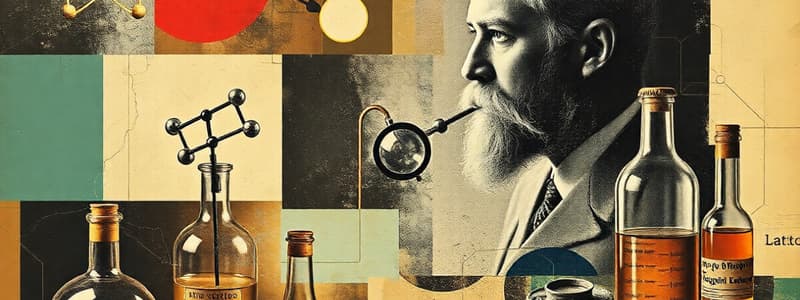Podcast
Questions and Answers
Which statement accurately reflects a key difference between the atomic theories of the ancient Greeks and John Dalton?
Which statement accurately reflects a key difference between the atomic theories of the ancient Greeks and John Dalton?
- Dalton's theory included the concept of four elements (fire, earth, air, and water), which was absent in the ancient Greek theories.
- Dalton supported his theory with experimental evidence and quantitative analysis, whereas the ancient Greeks relied on philosophical reasoning. (correct)
- Ancient Greeks accurately determined the atomic weights of several elements, a feat Dalton was unable to achieve.
- Ancient Greeks proposed that atoms combine in fixed, whole-number ratios to form compounds, while Dalton believed atoms existed independently.
According to Dalton's atomic theory, what distinguishes atoms of different elements from one another?
According to Dalton's atomic theory, what distinguishes atoms of different elements from one another?
- Atoms of different elements have the same mass but differ in size.
- Atoms of different elements are composed of the same fundamental particles, but in different arrangements.
- Atoms of different elements possess distinct properties. (correct)
- Atoms of different elements exhibit identical chemical behavior but vary in physical state (solid, liquid, gas).
Which of the following statements is a direct consequence of Dalton's postulate that atoms are neither created nor destroyed during a chemical reaction?
Which of the following statements is a direct consequence of Dalton's postulate that atoms are neither created nor destroyed during a chemical reaction?
- The total number of molecules remains constant during any chemical change.
- The total mass of the reactants equals the total mass of the products. (correct)
- The volume of reactants must equal the volume of products in a chemical reaction.
- Elements can be transmuted into other elements via chemical reactions.
A chemist performs a reaction in a sealed container. After the reaction, they measure the mass of the products and find it to be slightly less than the initial mass of the reactants. How would Dalton's atomic theory explain this discrepancy, assuming the experiment was performed correctly?
A chemist performs a reaction in a sealed container. After the reaction, they measure the mass of the products and find it to be slightly less than the initial mass of the reactants. How would Dalton's atomic theory explain this discrepancy, assuming the experiment was performed correctly?
Consider two compounds, water ($H_2O$) and hydrogen peroxide ($H_2O_2$). How does Dalton's atomic theory explain the difference in their properties?
Consider two compounds, water ($H_2O$) and hydrogen peroxide ($H_2O_2$). How does Dalton's atomic theory explain the difference in their properties?
Which observation would directly contradict Dalton's postulate that all atoms of a given element are identical in mass and other properties?
Which observation would directly contradict Dalton's postulate that all atoms of a given element are identical in mass and other properties?
In a chemical reaction, 10 grams of reactant A combine with 5 grams of reactant B to produce 12 grams of product C and some amount of product D. According to Dalton's Atomic Theory, what mass of product D was produced?
In a chemical reaction, 10 grams of reactant A combine with 5 grams of reactant B to produce 12 grams of product C and some amount of product D. According to Dalton's Atomic Theory, what mass of product D was produced?
If a sample of a pure compound always contains the same proportion of elements by mass, which of Dalton's postulates does this observation directly support?
If a sample of a pure compound always contains the same proportion of elements by mass, which of Dalton's postulates does this observation directly support?
Flashcards
Dalton's Atomic Theory
Dalton's Atomic Theory
A theory proposing that matter is made of indivisible atoms, foundational to modern chemistry.
Atoms
Atoms
The smallest units of an element that can undergo chemical changes.
Elements
Elements
Substances made up of only one type of atom, each with distinct properties.
Compounds
Compounds
Signup and view all the flashcards
Law of Conservation of Matter
Law of Conservation of Matter
Signup and view all the flashcards
Macroscopic Properties
Macroscopic Properties
Signup and view all the flashcards
Chemical Change
Chemical Change
Signup and view all the flashcards
Dalton's Postulates
Dalton's Postulates
Signup and view all the flashcards
Law of Definite Proportions
Law of Definite Proportions
Signup and view all the flashcards
Joseph Proust
Joseph Proust
Signup and view all the flashcards
Law of Multiple Proportions
Law of Multiple Proportions
Signup and view all the flashcards
John Dalton
John Dalton
Signup and view all the flashcards
Isooctane Example
Isooctane Example
Signup and view all the flashcards
Distinct Substances
Distinct Substances
Signup and view all the flashcards
Modern Relevance
Modern Relevance
Signup and view all the flashcards
Study Notes
Dalton's Atomic Theory
- Early Greek philosophers (Leucippus and Democritus) proposed the idea of indivisible particles (atomos).
- Aristotle's view, that matter was infinitely divisible, dominated for centuries.
- Dalton proposed a systematic atomic theory in 1807.
Postulates of Dalton's Atomic Theory
- Matter is composed of tiny, indivisible particles called atoms.
- Atoms of the same element are identical in mass and properties.
- Atoms of different elements have different masses and properties.
- Compounds form when atoms of different elements combine in small whole-number ratios.
- Atoms are neither created nor destroyed during chemical reactions; they are rearranged.
Implications of Dalton's Theory
- Explaining macroscopic properties: Dalton's theory explains why elements can't be broken down into simpler substances.
- Conservation of mass: Supports the law of conservation of mass during chemical reactions.
- Testing Dalton's theory: Analyzing the number of atoms before and after a reaction confirms if atoms are conserved.
Laws of Definite and Multiple Proportions
- Law of Definite Proportions: All samples of a pure compound contain the same elements in the same proportion by mass.
- Law of Multiple Proportions: When two elements form multiple compounds, the masses of one element combining with a fixed mass of the other element are in small whole-number ratios.
Examples and Applications
- Definite Proportions (Isooctane example): Isooctane always contains carbon and hydrogen in a constant ratio (5.33:1).
- Multiple Proportions (Carbon and Oxygen): Different compounds of carbon and oxygen exhibit different mass ratios of oxygen to carbon.
Conclusion
- Dalton's atomic theory revolutionized chemistry by providing a model for explaining chemical behaviors and substance composition.
- Its postulates and related laws remain fundamental to modern chemistry.
Studying That Suits You
Use AI to generate personalized quizzes and flashcards to suit your learning preferences.




